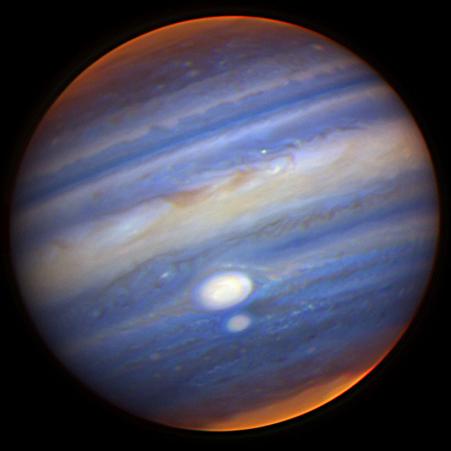A high-resolution photograph taken by the Gemini Observatory showed that the two giant red spots passed within a short distance of each other in the southern hemisphere

A high-resolution photograph taken at the Gemini Observatory showed that the two giant red spots passed within a short distance of each other in the planet's southern hemisphere.
The image was taken with equipment sensitive to near-infrared light, equipment similar to that used to track storms on Earth from space. In near infrared light, the spots appear white compared to their reddish color in visible light. "It was very tricky to capture this image," says astronomer Chad Trujillo of the Gemini Observatory, who helped lead the effort to capture the event. "Since we use corrective optics, we needed a close object to calibrate on, and therefore when the fair moon Io got close enough to Jupiter and the red spot was placed at a good viewing angle to us, it was an excellent time to take a picture. Fortunately, in the photograph from July 13th we also managed to capture the rare coincidence in which the two red spots - the old spot and the relatively new spot - are in maximum proximity."
The two red dots are massive storm systems. The height of the largest of them - known as the Great Red Spot, which has been followed since Galileo's time - is about 8 kilometers above the cloud tops nearby, and is the largest known hurricane in the solar system. The smaller storm, officially known as Oval BA, but more commonly known as Red Spot Jr., is a similar hurricane. Its height is also apparently similar to that of the big spot.
The size of the small spot Jr. is about half that of our famous uncle, but the winds blow there with the same force. It was apparently formed between 1998 and 2000 by the merger of three old white spots, each a smaller-scale storm, that had been observed for 60 consecutive years. It was only in February of this year that an amateur astronomer from the Philippines discovered that it had turned a red color like that of red building tiles. Astronomers witnessed the birth of a new red spot.
No one knows why the spot changed color from white to red. However, astronomer Toby Owen from the University of Hawaii supports the hypothesis that the merging of the three storms led to the formation of a formidable storm system, which was strong enough to bring up red matter from the depths of the atmosphere. When this material reached the middle of the spot, it escaped escape due to the circular currents at the edges of the spot. "What's frustrating is that we don't know what the red stuff is," Owen said, "but the ability to float it up seems to depend on the size of these storm systems."
